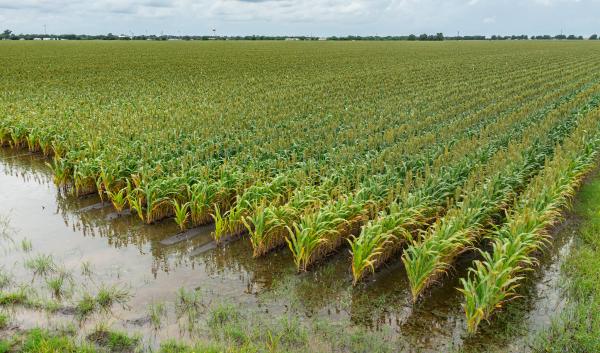Nutrient management guidelines have largely been developed to protect water quality, but practices that improve nitrogen (N) use efficiency by crops also help reduce emissions of the potent greenhouse gas nitrous oxide (N2O).
Agriculture is the largest source of N2O, with a majority produced in soils receiving fertilizer and manure. The largest emissions of N2O generally come from wet soils. (See here for more details on how N2O is produced). Following the 4 R’s of nutrient management (right source, right rate, right time, and right place) helps to maximize crop uptake of N and reduce the amount of N that is lost to leaching, runoff, or as gases (including N2O and ammonia). Setting realistic yield goals, based on multiple years of crop yield data, is the first step in efficient N management. Applying as much of the N as practical while the plants are actively growing helps maximize crop uptake. When all or most of the N for the growing season is applied before or at the time of planting of an annual crop, there is a window of several weeks with little plant uptake when soil N is easily lost. Applying all N early usually means that application rates need to be larger to make up for lost N. Splitting applications of N fertilizers, so that much of the N is applied mid-season when crops have high N demand, is an effective approach to increase the N use efficiency and reduce N2O emissions. For tall crops like corn, it may not be possible to apply fertilizers at the time of highest N demand (pollination and ear fill for corn) but delaying application of as much of the fertilizer as long as possible does reduce the time that fertilizer N can be lost. In irrigated crops, fertigation can “spoon feed” the crop, maximizing N uptake and reducing N2O production.
CAPTION: USDA ARS researchers side-dressing N into a corn crop. Delaying N fertilizer application until the crop is growing allows for increased plant uptake and reduces the amount of N that is left to be converted to N2O. | Photo courtesy of USDA ARS
The use of enhanced efficiency fertilizers (EEF; slow-release or inhibitor treated) can also reduce N2O emissions in some cases. These fertilizers help delay the conversion of fertilizer N to nitrate (the form of N that is most easily lost) until a time when plants have higher N demand. However, additional research is needed to provide management guidelines for EEFs in a wider range of cropping systems. The additional cost for these products is also a concern for farmers.
Since it is usually practical to apply manure only before annual crops are planted, improving N use efficiencies in manure-fertilized systems can be more challenging than when using commercial fertilizers. However, applying moderate rates of manure before planting then side-dressing with commercial fertilizer, if needed, can increase N use efficiency. Using tools like pre-sidedress nitrate tests (PSNT) can help determine if mid-season soil N is sufficient to support the yield goal or if the crop would respond to a side-dress application. Additionally, decision making tools are available which use manure N content and application rate, weather data, and other information to estimate if the crop has sufficient N or if it would benefit from side-dress N.
There is no silver bullet for eliminating N2O emissions from the production of crops requiring N fertilization. However, the use of available nutrient management tools can help to maximize plant N uptake and limit the quantity of excess N in that can be converted to N2O. Reducing the quantity of N applied by increasing N use efficiency can reduce costs while maintaining crop yields and increasing profit.




